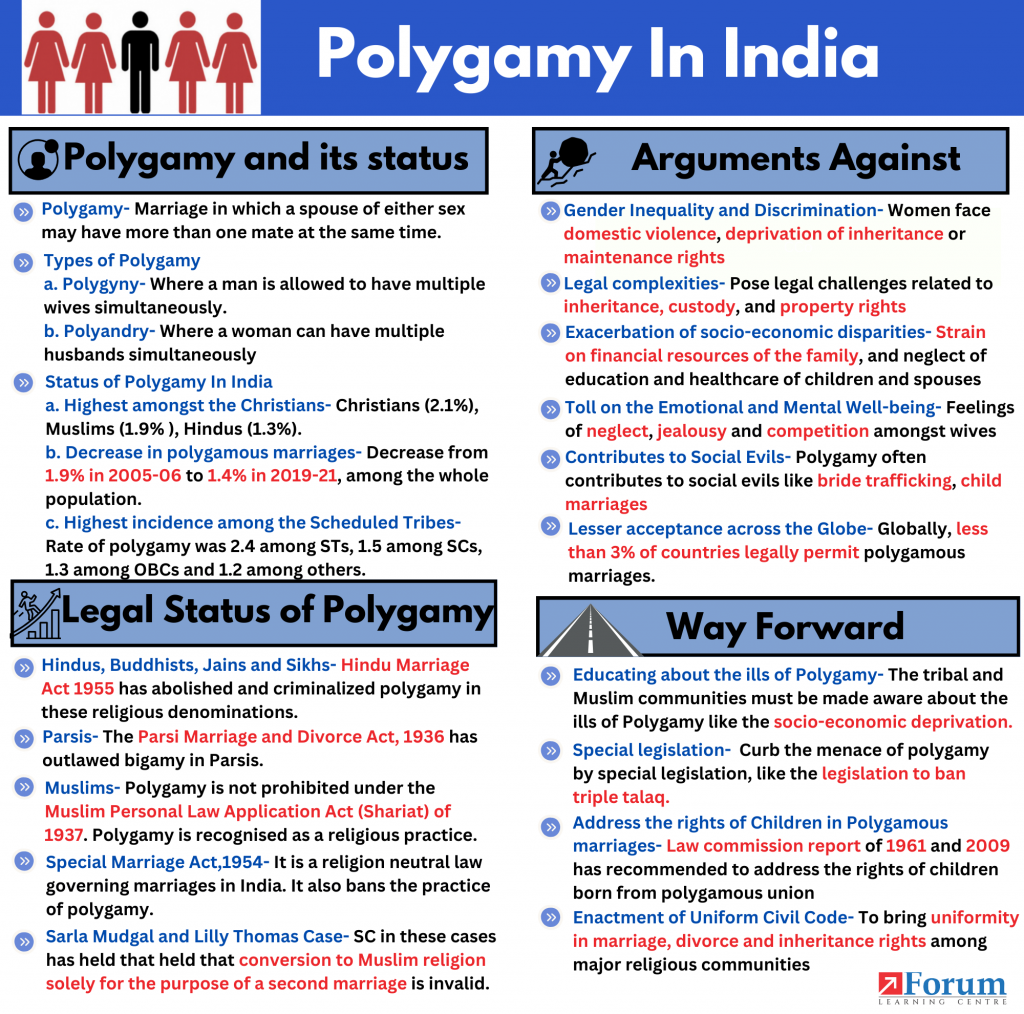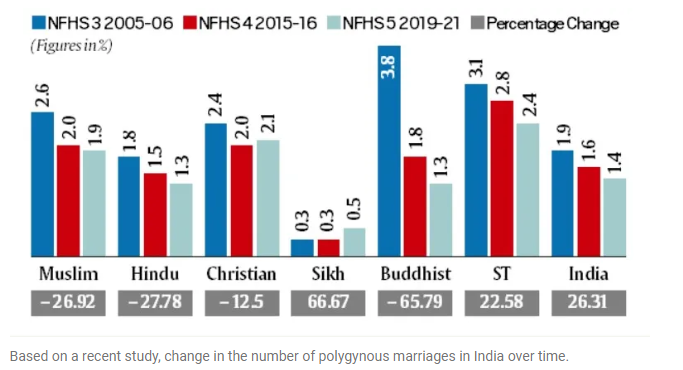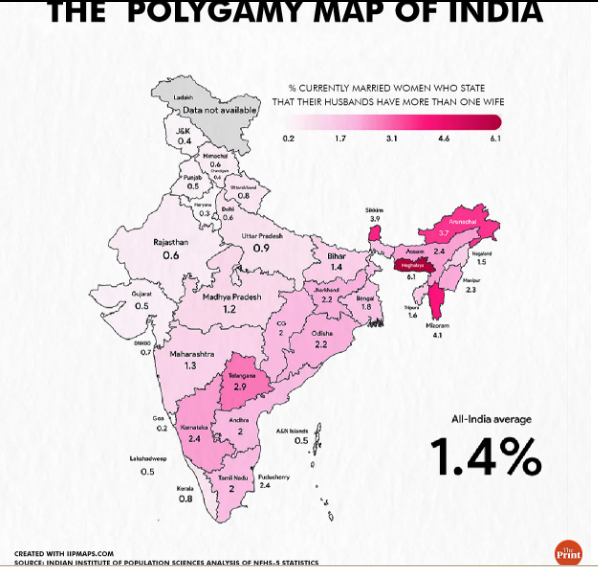ForumIAS announcing GS Foundation Program for UPSC CSE 2025-26 from 19 April. Click Here for more information.
The recently passed Uttarakhand Uniform Civil Code (UCC) has banned the practice of polygamy in the State. The Assam government has also made a move to ban the practice of polygamy through ‘legislative action’, and has constituted an ‘expert committee’ to examine the issue. Polygamy has become a recurring topic in the ongoing discussions about the Uniform Civil Code (UCC) in India.

What is Polygamy? What are the Different types of Polygamy?
Polygamy- Polygamy comes from two words- “poly” which means “many” and “gamos” which means “marriage”. Polygamy is marriage in which a spouse of either sex may have more than one mate at the same time.
Types of Polygamy- The practice of Polygamy can take various forms which are explained below:
| Polygyny | This is a polygamous marriage, where a man is allowed to have multiple wives simultaneously. This is the most common form of polygamy and is the recurring issue of debate in India. |
| Polyandry | This is polygamous marriage, where a woman can have multiple husbands simultaneously. This is a less common form in India. |
| Group Marriage | This form involves multiple men and multiple women entering into a marriage arrangement together. |
The prevalence of polygamy varies across different cultures and societies, and it often carries significant social and cultural implications.
What is the status of Polygamy in India?
1. Religion wise percentage of Polygamy – According to the National Family Health Survey-5 (2019-20), the prevalence of polygamy was 2.1% among Christians, 1.9% among Muslims, 1.3% among Hindus, and 1.6% among other religious groups.
2. Decrease in polygamous marriages- A study by the International Institute of Population Sciences (IIPS) titled ‘Polygyny in India: Levels and Differentials’ has analysed data from the NFHS-3 (2005-06), NFHS-4 (2015-16) and NFHS-5 (2019-21). It showed that polygynous marriages (one man married to more than one woman at a time) have decreased from 1.9% in 2005-06 to 1.4% in 2019-21, among the whole population.

3. Highest incidence among the Scheduled Tribes- Compared to the national average of 1.4 per cent (NFHS-5), the rate of polygamy was 2.4 among STs, 1.5 among SCs, 1.3 among OBCs and 1.2 among others.
4. High prevalence in North Eastern states District- East Jaintia Hills (20%), Kra Daadi (16.4%), West Jaintia Hills (14.5%), and West Khasi Hills (10.9%) have particularly high rates of polygynous marriages.

Is Polygamy Legal in India?
| Hindus | The Hindu Marriage Act 1955 has abolished and criminalized Hindu polygamy. There are provisions of punishment for Hindu Polygamy under Section 17 of the Hindu Marriage Act 1955 and Sections 494 and 495 of the Indian Penal Code, 1860. |
| Buddhists, Jains and Sikhs | The Hindu Marriage Act 1955 is applicable to Buddhists, Jains and Sikhs, and hence polygamy is prohibited in these three religious denominations as well. |
| Parsis | The Parsi Marriage and Divorce Act, 1936 has outlawed bigamy in Parsis. |
| Muslims | Polygamy is not prohibited under the Muslim Personal Law Application Act (Shariat) of 1937. Polygamy is recognised as a religious practice under the Shariat Act 1937. Sections of IPC penalising polygamy are not applicable. |
Special Marriage Act,1954 which is a religion neutral law governing marriages in India also bans the practice of polygamy.
What are the reasons for the practice of polygamy in India?
1. Cultural and Religious Practice- Polygamy is considered a traditional or religious practice, in certain communities. For ex- Polygamy is recognised as a religious practice under the Shariat Law.
2. Infertility or Health Issues- Polygamy is also practised when a spouse is unable to bear children due to infertility or health issues.
3. Widow Remarriage and Social Security- In certain communities, Polygamy is practised to provide social security to young widows in the family. For ex- Practised in certain tribal communities
4. Exercise of Personal Choice and Freedom- Polygamy is used to assert the right to choose one’s marital arrangement with the consent of all parties involved.
What are the arguments against the practice of Polygamy in India?
1. Gender Inequality and Discrimination- Polygamy leads to unequal power dynamics within the family and leads to discrimination and emotional distress of the wives. For ex- Women face domestic violence, deprivation of inheritance or maintenance rights. Also, the right to polygamy is often exploited by the males in the family, which highlights the deeply entrenched patriarchy in Indian society.
2. Legal complexities- Polygamous marriages pose legal challenges related to inheritance, custody, and property rights, which increase legal disputes in the family and increase the burden on already over-burdened judiciary.
3. Exacerbation of socio-economic disparities- The financial burden of supporting multiple wives and children leads to a strain on financial resources of the family, which affects the socio-economic well-being of the family members. For ex- Neglect of education and healthcare of children and spouses.
4. Toll on the Emotional and Mental Well-being- Polygamous marriages lead to emotional distress for women as they often face mental health issues due to feelings of neglect, jealousy and competition.
5. Contributes to Social Evils- Polygamy often contributes to social evils like bride trafficking, child marriages.
6. Criminalization versus personal law rights- Predominance of Muslim personal law over general law like IPC, has often stirred furious debates in the country.
7. Lesser acceptance across the Globe- Globally, less than 3% of countries legally permit polygamous marriages. India is one of the few countries outside of Africa and the Middle East where polygamy is legally sanctioned for certain communities.
What are the judicial observations regarding polygamy?
1. Parayankandiyal v. K. Devi & Others (1996)- The Supreme Court (SC) concluded that monogamous relationships are the standard and ideology of Hindu society.
2. Javed & Others v. State of Haryana & Others (2003)- The SC held that Article 25 which guarantees religious freedom is subject to social harmony, dignity, and wellness. It is not compulsory for a Muslim to indulge in polygamy.
3. Sarla Mudgal Case (1994)- SC held that conversion to Muslim religion solely for the purpose of a second marriage is invalid.
4. Lilly Thomas Bigamy Case (2000)- SC ruled that a marriage would be considered void if a man entered into a second marriage without first divorcing his first wife, who is still alive.
What should be the Way Forward?
1. Educating about the ills of Polygamy- The tribal and Muslim communities must be made aware about the ills of Polygamy like the socio-economic deprivation.
2. Special legislation- Special legislation need to be brought to curb the menace of polygamy, like the legislation to ban triple talaq.
3. Address the rights of Children in Polygamous marriages- Law commission report of 1961 and 2009 has recommended to address the rights of children born from polygamous union.
4. Enactment of Uniform Civil Code- Uniform civil code needs to be enacted at the earliest to bring uniformity in marriage, divorce and inheritance rights among major religious communities, in consonance with constitutional values.
| Read More- The Indian Express UPSC Syllabus- GS 2- Issues related to Fundamental rights and constitution |





